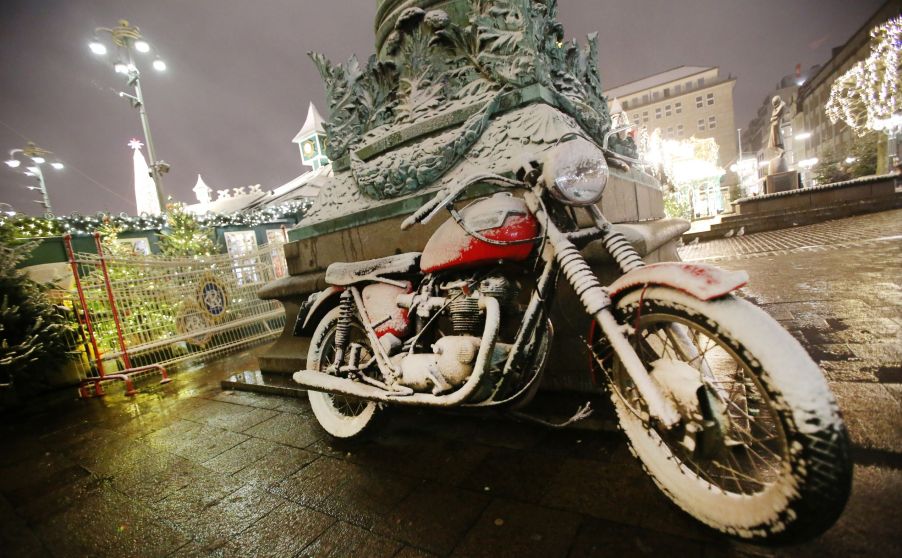
How Should You Store Your Motorcycle for the Winter?
As fun as it would be to camp and ride your motorcycle throughout the year, the weather doesn’t always cooperate. Especially in northern states and climates, where winter pumps the brakes on riding. However, just like with cars, improper storage can damage your bike. But getting your motorcycle ready for its winter nap doesn’t have to be difficult.
Planning and gearing up for motorcycle winter storage

‘Winterizing’ a motorcycle is, at its core, another kind of maintenance, Revzilla explains. Only instead of replacing worn parts or old fluid, you’re making sure you don’t have to do that after the bike sits idle for several months. And it starts with knowing where you’ll be leaving the motorcycle throughout the winter.
The best place is a secure garage or shed, preferably one with access to a power outlet. If you don’t have one of your own, you can rent a self-storage unit, RideApart reports. But if that’s not an option, at the very least get a water-proof, UV- and mildew-resistant cover, Motorcyclist reports.
Storing a motorcycle for the winter is about preservation. That means preventing things like corrosion, tire flat spots, and rubber degradation. It also means making sure the bike starts come the spring. Luckily, the vast majority of the equipment you’ll need should already be in your toolbox.
Most motorcycle owner’s manuals have instructions on proper winter storage. When in doubt, consult that. However, the overall preparation process is fairly universal.
Preparing your motorcycle for winter storage
First, make sure that your motorcycle has fresh anti-freeze before winter sets in. Changing the engine oil and oil filter is recommended, but not strictly necessary, RideApart reports. However, since any grime in the oil will sit there for months, changing it isn’t a bad idea.
As a bare minimum, you have to take care of your bike’s fuel system and battery, Motorcyclist explains. Especially if it’s a classic bike; fuel injectors can clog, but carburetors do so more easily.
Some drain the fuel tank completely using a siphon, Cycle World reports. However, a more common—and easier—practice is to add some fuel stabilizer to the tank. This prevents the ethanol and gasoline from separating and causing internal damage, Cycle World explains. You’ll have to let the mixture work its way throughout the fuel system to get the best effect. To make things easy, add the fuel stabilizer to a near-empty tank at a gas station, fill up, then ride back home. Just be sure not to add too much, Motorcyclist warns.
As with cars, bike batteries can go flat if they’re not used. That’s especially true in cold temperatures, which interfere with battery chemistry. To prevent this, plug the battery into a trickle or float charger so it doesn’t discharge. If your winter storage area doesn’t have a socket, you’ll have to remove the battery from the motorcycle.
After that, raise your bike on a wheel stand and remove the spark plugs, FortNine reports. Add some oil to each plug hole, then rotate the rear wheel. This makes sure the plugs and sockets are protected from corrosion.
Finally, before you say goodnight to your motorcycle for the winter, make sure it’s clean and free of debris. Then, raise the bike on its center stand, or onto separate wheel stands. If you don’t have wheel stands, or only have one, put some plywood underneath the tires, RideApart reports. This helps prevent tire flat spots.
What to do when the spring comes
Throughout winter, try to check on your motorcycle regularly, especially to make sure its battery isn’t over- or under-charged. And if you don’t have wheel stands, rotate the tires to prevent flat spots.
However, once you’ve done all the prep-work, do NOT start the bike again until the spring. Cold starts can damage the engine, Revzilla explains, and can cause condensation to build up.
Once winter is over, though, feel free to start your motorcycle again. Just let it warm up a bit before you really rev it up. If you’ve added a fuel stabilizer, your fuel should be good to go. But if you’re worried, drain the tank and add fresh fuel, Ultimate Motorcycling reports. Ditto with the coolant.
Double-check that the brakes haven’t seized and that there aren’t any new leaks. Also, reinstall the battery and check that all the electrics and wiring work. Plus, make sure the tires have sufficient pressure and haven’t developed cracks. And, if you didn’t change the oil before you put the motorcycle in winter storage, do that now.
Follow more updates from MotorBiscuit on our Facebook page.


